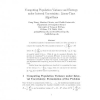Free Online Productivity Tools
i2Speak
i2Symbol
i2OCR
iTex2Img
iWeb2Print
iWeb2Shot
i2Type
iPdf2Split
iPdf2Merge
i2Bopomofo
i2Arabic
i2Style
i2Image
i2PDF
iLatex2Rtf
Sci2ools
RC
2007
2007
Computing Population Variance and Entropy under Interval Uncertainty: Linear-Time Algorithms
In statistical analysis of measurement results, it is often necessary to compute the range [V , V ] of the population variance V = 1 n · n i=1 (xi −E)2 (where E = 1 n · n i=1 xi) when we only know the intervals [xi − ∆i, xi + ∆i] of possible values of the xi. While V can be computed efficiently, the problem of computing V is, in general, NP-hard. In our previous paper, we showed that in a practically important case, we can use constraints techniques to compute V in time O(n · log(n)). In this paper, we provide new algorithms that compute V and, for the above case, V in linear time O(n). Similar linear-time algorithms are described for computing the range of the entropy S = − n i=1 pi · log(pi) when we only know the intervals pi = [pi , pi] of possible values of probabilities pi. 1 Computing Population Variance under Interval Uncertainty: Formulation of the Problem Once we have n measurement results x1, . . . , xn, the traditional statistical analysis starts with computin...
Related Content
| Added | 28 Dec 2010 |
| Updated | 28 Dec 2010 |
| Type | Journal |
| Year | 2007 |
| Where | RC |
| Authors | Gang Xiang, Martine Ceberio, Vladik Kreinovich |
Comments (0)

